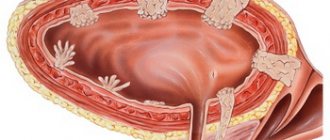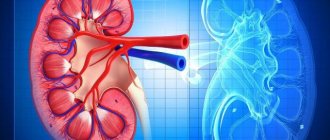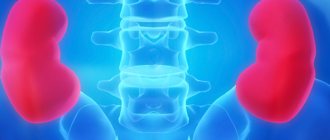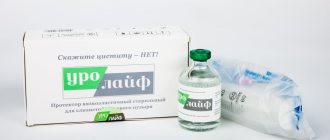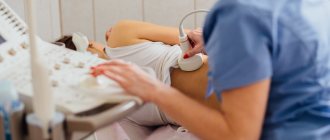Table of contents
- General information and classification of uroseptics
- Pyelonephritis
- Pyelitis
- Cystitis
- Urethritis
- Brief characteristics of some uroseptics
- Fluoroquinolones
- Penicillins
- Cephalosporins
- Quinolone derivatives
- 8‑hydroxyquinolones
- Nitrofuran derivatives
- Naphthyridine derivatives
- Plant uroseptics
- Features of the use of uroseptics
There are many medications available to treat urinary tract infections. In this article we will try to systematize all the information, focusing on the most basic.
Postcoital cystitis: description
Postcoital cystitis is a recurrent disease associated with inflammation of the bladder wall, developing 12-36 hours after sexual intercourse (less often than other vaginal manipulations).
According to statistics, about 10-12% of all chronic cysts are associated with this pathology. Sometimes this disease can occur after childbirth, which was accompanied by ruptures of the perineum or vagina. Unfortunately, the correct diagnosis is not always made on time, and the patient takes medication for a long time and to no avail, and stops having sex, which in turn greatly affects her internal state.
The reasons for the development of this disease include anatomical hypermobility of the distal urethra, caused by the formation of hymenurethral adhesions - adhesions between the remnants of the hymen and the external opening of the urethra. Due to their tension during sexual intercourse, the external opening of the urethra moves towards the vagina, which contributes to damage to the mucous membrane and the reflux of vaginal secretions into the urethra.
Another reason leading to this pathology is urethral ectopia (a congenital anomaly associated with the “wrong” location of the external urethral opening. Sometimes the urethral opening is located closer to the vagina, and sometimes it can be located directly on its anterior wall, which also contributes to the reflux of vaginal secretions in urinary tract.
In 20-30% of patients with postcoital cystitis, there are no anatomical defects. In such cases, the main prerequisites for the rapid spread of infection after sexual intercourse are inflammatory diseases of the genital organs (colpitis, cervecitis), high sexual activity with frequent changes of partners, abuse of contraceptive spermicides, and increased vaginal dryness.
For doctors
Interstitial cystitis: conservative treatment. Part 1. Previous article
The diagnosis of interstitial cystitis
(Painful Bladder Syndrome)
can be made based on symptoms such as chronic pelvic pain, pressure or discomfort associated with bladder filling, accompanied by pollakiuria and/or urinary urgency. Further diagnosis is based on cystoscopy with hydrobouge and the results of morphological examination.
Conservative therapy of interstitial cystitis is aimed primarily at the so-called non-ulcerative form of interstitial cystitis, which is characterized by the absence of Hunner's lesions during cystoscopy, the presence of glomerulations during cystoscopy with hydrobouge and characteristic morphological changes (increased number of macrophages, granulation tissue, inflammatory infiltrate).
I. Oral therapy
Analgesics
Since pain is the main symptom of interstitial cystitis, reducing the intensity of pain is the primary goal of therapy. For this purpose, patients actively use non-steroidal anti-inflammatory drugs. Unfortunately, due to the involvement of the visceral and neuropathic components in the pathogenesis of pain in interstitial cystitis, NSAIDs are usually ineffective.
Narcotic analgesics are more effective and can be used for short-term pain relief when pain increases. Since interstitial cystitis is a chronic disease, long-term use of narcotic analgesics is possible in severe cases, but with extreme caution (1).
Glucocorticoids
Publications on the results of the use of glucocorticoids in interstitial cystitis are very contradictory and show both promising (2) and disappointing results (3). Soucy proposed the use of prednisolone in the ulcerative form of interstitial cystitis, refractory to other types of therapy (4). It should be noted that the serious side effects of glucocorticoids make their long-term use difficult.
Antihistamines
Macrophages are known to play an important role in the pathogenesis of interstitial cystitis. Since their degranulation releases many biologically active substances, including histamine, the use of histamine receptor blockers seems quite logical. There are studies on the results of using H1 (5) and H2 (6) receptor blockers, with rather contradictory results.
Hydroxyzine
Hydroxyzine (Atarax) is an H1 receptor blocker with interesting additional properties: it blocks neuronal activation of macrophages by inhibiting serotonin synthesis by thalamic macrophages. Side effects include drowsiness and general weakness, which, however, in most cases disappear during treatment (7). According to Theoharides, 90% of patients reported feeling better.
An interesting fact is that patients with interstitial cystitis and concomitant irritable bowel syndrome and migraine also showed a decrease in the symptoms of these diseases (5). In contrast to the impressive results of pilot studies (5,8), a prospective, randomized, placebo-controlled trial did not show a statistically significant difference between hydroxyzine and placebo (9). However, the combination of hydroxyzine and oral pentosan polysulfate was effective in 40% of cases, versus 13% with placebo.
Amitriptyline
The tricyclic antidepressant amitriptyline reduces the severity of pain, pollakiuria and urgency in interstitial cystitis. A possible mechanism of action of amitrityline is blockade of m-cholinergic receptors in the bladder, inhibition of the reuptake of serotonin and norepinephrine, and blockade of H1 receptors. In addition, amitriptyline is an anxiolytic (10).
Several studies have demonstrated the effectiveness of oral amitriptyline in interstitial cystitis (11–13). In one prospective study, 4 months of amitriptyline resulted in a statistically significant reduction in pain and urgency, while functional bladder capacity and pollakiuria changed, but not significantly (14).
In subsequent studies, 64% of patients showed a positive result after 20 months of taking amitriptyline. 46% of study participants reported good or excellent response to amitriptyline (15,16). Amitriptyline showed a statistically significant improvement compared with placebo. Side effects included weight gain and drowsiness.
Pentosan polysulfate
Pentosan polysulfate (Elmiron) is believed to help restore defects in the protective glycosaminoglycan layer of the bladder. A significant improvement in the symptoms of interstitial cystitis (pain, pollakiuria, urgency) was recorded as a result of a course of oral glycosaminoglycan replacement therapy with pentosan polysulfate. No improvement in nocturia was noted. Pentosan polysulfate therapy has been shown to be more effective in patients with Hunner's lesions of the bladder compared with nonulcerative interstitial cystitis (19).
The standard therapeutic dose of 150-200 mg twice daily between meals has demonstrated insufficient absorption in the gastrointestinal tract and, consequently, low bioavailability of the drug. One study compared doses of 300, 600 and 900 mg, which demonstrated sufficient effectiveness, which, however, was not dose-dependent. The effectiveness of oral glycosaminoglycan replacement therapy with pentosan polysulfate depended more on the duration of the course. Half of the study participants showed positive results after 32 weeks of pentosan polysulfate therapy. No significant side effects were noted.
In patients with insufficient effectiveness of oral therapy for interstitial cystitis with pentosan polysulfate, the effectiveness of subcutaneous injections of heparin was demonstrated according to the following scheme: starting dosage - 5000 units 2-3 times a day for 12 days, then moving to a maintenance dose of 5000 units 1 time per day for 6 months (required period for urothelial restoration) (21).
Chondroitin sulfate, sodium hyaluronate
So far, only a small number of studies have focused on the effectiveness of oral glycosaminoglycan replacement therapy with chondroitin sulfate and sodium hyaluronate (“IALuril” soft gels, “Urolife”). However, data from pilot studies indicate a reduction in pain and pollakiuria in patients with defects in the glycosaminoglycan layer of the bladder (interstitial and radiation cystitis). The dosage was 200 – 400 mg of chondroitin sulfate three times a day for 3-6 months. (36).
Antibiotics
The role of antibacterial drugs in the treatment of interstitial cystitis appears to be very limited, although some studies have demonstrated a decrease in pain and urgency with antibacterial therapy (22).
Immunosuppressants
According to Oravisto, azathioprine therapy reduces pain and pollakiuria in patients with interstitial cystitis (23). Pilot studies of the effectiveness of cyclosporine A (24) and methotrexate (25) demonstrated a good analgesic effect with a minor effect on pollakiuria and urgency.
Relatively recent studies of the effectiveness of cyclosporine A have shown promising results with significant reductions in urinary frequency, increases in functional bladder capacity, and increases in urine output after 1 year of therapy. With continued therapy, the achieved effect was maintained during 5 years of observation, with most patients reporting no pain in the bladder area. However, when therapy was discontinued, a recurrence of interstitial cystitis symptoms was observed after several months (26, 27).
Further studies (27) showed that a 6-month course of cyclosporine A was more effective compared with the same course of pentosan polysulfate for all symptoms of interstitial cystitis (75% of participants receiving cyclosporine noted positive changes compared with 19% in the group pentosan polysulfate).
However, significant side effects in the cyclosporine group (pain in the gums, muscles, abdomen, hot flashes, cramps, etc.) led to the discontinuation of participation in the study by some patients. Careful monitoring of the patient with regular measurement of blood pressure and assessment of blood creatinine levels is necessary during immunosuppressant therapy. The daily dose of cyclosporine A is 3-3.5 mg/kg body weight, twice a day.
Gabapentin
Gabapentin is a drug for the treatment of epilepsy, but is also widely used as a treatment for neuropathic pain. The use of gabapentin may reduce the dosage of other analgesics, including narcotics. In one study, two patients with interstitial cystitis reported increased functional bladder capacity and adequate pain relief after adding gabapentin to their treatment regimen (29).
In another study of 21 patients with chronic pelvic pain syndrome, 10 reported improvement after 6 months of gabapentin (30). The study involved 8 patients with interstitial cystitis, 5 of them reported a positive effect of gabapentin. The recommended starting dose of gabapentin is 300 mg 3 times a day, subsequently the daily dose is titrated to 1800 mg.
Pregabalin
Pregabalin (Lyrica) is one of two drugs approved by the FDA for the treatment of neuropathic pain (31) and is used to treat diabetic and postherpetic neuropathy. There are no studies on the effectiveness of pregabalin in interstitial cystitis, with the exception of a clinical case described by the Indian urologist Lakshmi.
A 52-year-old woman received 75 mg of pregabalin twice daily along with 10 mg of amitriptyline, noting a slight improvement. The starting dose of pregabalin is usually 75 mg twice daily, gradually increasing to 300 mg twice daily.
Quercetin
Quercetin is a bioflavonoid that may be effective for CPPS in men (33). Theoharides et al conducted a study on the effectiveness of CystoProtek (34), containing quercetin, chondroitin sulfate, and sodium hyaluronate. The patients' condition improved significantly after a 6-month course of therapy. Unfortunately, there are no data from comparative studies.
Tanezumab
Tanezumab is a human monoclonal antibody to nerve growth factor. Increased production of Nerve Growth Factor by macrophages is one of the reasons for the increase in the number of vanilloid and purine receptors in the urothelium and leads to the appearance of symptoms such as pain, urgency and pollakiuria. With the use of tanezumab, regression of these symptoms is observed after 6 weeks (35).
II. Instillations into the bladder
The advantage of intravesical administration of drugs is the creation of a high concentration of the active substance in the lesion with a minimum of side effects. The disadvantages are the need for catheterization, which can be painful in interstitial cystitis, and the risk of infectious complications.
Lidocaine
There are several publications on the successful treatment of interstitial cystitis using lidocaine instillation into the bladder (37,38). Alkalinization of lidocaine solution improves its pharmacokinetics (39). The CLParsons study showed that instillation of a combination of 1-2% lidocaine, heparin and sodium bicarbonate resulted in immediate relief of pain and irritative symptoms in 94% of patients (40). According to JCNickel, instillation of lidocaine and sodium bicarbonate for 5 days leads to improvement for up to 1 month (41).
Pentosan polysulfate
Pentosan polysulfate is also used intravesically, due to low bioavailability when taken orally. After 3 months of therapy with intravesical instillations of pentosan polysulfate, 40% of patients reported significant improvement, whereas in the group receiving placebo (saline) instillations, only 20% reported improvement (42). Bladder capacity increased only in the group receiving pentosan polysulfate.
After 18 months of therapy, 80% of the pentosan polysulfate group and 40% of the control group reported improvement. In another comparative randomized trial, women with interstitial cystitis were divided into two groups:
1) pentosan polysulfate orally and intravesical instillation;
2) pentosan polysulfate orally and intravesical instillation of placebo.
The course of instillations lasted 6 weeks, taking pentosan polysulfate per os lasted up to 12 weeks. Both groups showed improvement, but the improvement was greater in the combination therapy group (43).
Heparin
Instillation of heparin into the bladder has been proposed to protect the urothelium from the effects of potassium ions and also to restore its protective glycosaminoglycan layer. Half of patients with interstitial cystitis who received heparin instillation for 3 months reported improvement (44).
Kuo et al reported that 80% of participants with a positive KCl test reported improvement after 3 months of heparin instillation (45).
Baykal et al studied the effectiveness of heparin instillation in combination with electrical stimulation of the tibial nerve and noted a decrease in pain, pollakiuria and an increase in bladder capacity (46).
Hyaluronic acid (sodium hyaluronate)
Sodium hyaluronate is a natural proteoglycan that repairs defects in the glycosaminoglycan layer of the bladder. Positive results from sodium hyaluronate instillation were reported by 56% of patients at week 4 of therapy and by 71% at week 7 (47). After 24 weeks, the effectiveness of hyaluronic acid instillations decreased.
Nordling et al (48) and Kallestrup et al (49) published the results of a 3-year follow-up of patients who received sodium hyaluronate instillation for 3 months. A positive long-term effect was demonstrated by 2/3 of patients. Another study (50) showed similar results with hyaluronic acid instillations in patients with a positive KCl test.
Participants received weekly instillations of 40 mg sodium hyaluronate (50 ml 0.08% solution) for 10 weeks. Pain syndrome was assessed using a visual analogue scale. Also, one study assessed the long-term results of intravesical sodium hyaluronate (51). 50% of respondents reported complete remission without additional therapy and 41.7% reported improvement after a second course of treatment.
Chondroitin sulfate
Intravesical instillation of chondroitin sulfate (52) demonstrated efficacy in two non-randomized pilot studies. Steinhoff (53) instilled chondroitin sulfate once a week for 4 weeks and then once a month for 12 months.
Results after 3-12 weeks of therapy were as follows:
— good effect – 46.2%; — positive effect – 15.4%; — partial effect – 30.8%; – no effect – 7.7%.
In the second study (54), patients were treated with a high concentration of chondroitin sulfate solution (2%) - two instillations per week for 2 weeks and then a 0.2% solution once a week for 4 weeks, then once a month during a year.
Positive results were demonstrated by 73.1% of patients; the time to achieve maximum effect was 4-6 months. Maintenance instillations with a 2% solution were more effective than 0.2%. The results of comparative randomized placebo-controlled studies showed that the effectiveness of chondroitin sulfate instillations (39.4%) was higher than placebo (22.6%), although the difference was not statistically significant (55.56).
Dimethyl sulfoxide
The effectiveness of dimexide instillations for interstitial cystitis was found empirically, but is now standard treatment. In a placebo-controlled study, patients received instillations of dimexide once every two weeks - eight instillations per course. The therapy was subjectively effective in 53% of cases compared to 18% in the placebo group. Objective improvement was demonstrated by 93% versus 35%, respectively (57).
Despite the sufficient number of proposed treatment methods, interstitial cystitis still seems to be a practically incurable disease. Thus, the goal of therapy is to achieve a more or less long-term remission, or adequate control of pain and pollakiuria. For this purpose, the following are most often used:
Oral therapy:
- Amitriptyline - starting with 12.5 mg twice a day and increasing, if necessary, the dosage up to 100 mg/day;
— Atarax – 25 mg 2-3 times a day;
— Pentosan polysulfate – at least 900 mg/day in three doses with a course of treatment of at least 6 months;
— Chondroitin sulfate – at least 900 mg/day in three doses, 6 months
Intravesical therapy:
— Lidocaine 1-2% solution – instillation into the bladder 3–7 times a week
— Glucocorticoids
— Dimexide 5% — instillations into the bladder 2-3 times a week, 8 instillations per course of treatment;
- Sodium hyaluronate 0.08% or 0.12% solution - instillation into the bladder 1-2 times a week, up to 24 instillations per course of treatment;
-Heparin – 10,000 units intravesically, 1-2 times a week;
— Chondroitin sulfate 0.2%, 2% solution — instillations into the bladder 1-2 times a week, up to 24 instillations per course of treatment.
Read the next article Interstitial cystitis: conservative treatment. Part 2.
Treatment of postcoital cystitis
If there is no effect from drug therapy, surgical treatment is indicated. Currently, two types of operational aids are used.
If there are hymenurethral adhesions, they are transversely dissected and longitudinally sutured. The effectiveness of the operation is checked intraoperatively with the O'Donnell-Hirschhorn test.
If there is ectopia of the urethra, its transposition is performed (according to B.K. Komyakov). The purpose of this operation is to mobilize the urethra and move it closer to the clitoris. Thus, during sexual intercourse, vaginal secretions are not thrown into the urethra, and the patient can forget about this unpleasant illness for a long time.
How is the operation performed?
These operations are classified as minimally invasive and are usually quite easily tolerated by patients. Currently, they are most often performed under spinal anesthesia. The length of stay in the hospital is about 3 days. The operation ends with the installation of a urethral catheter; on the third day it is removed, and the patient is discharged home. At home, the patient is prescribed antibacterial, anti-inflammatory therapy, physical and sexual rest for some time. After final recovery, patients return to normal life. The effectiveness of the operation is about 80-85%.
Cystitis
Cystitis is widespread in women and men, but the fair sex is more likely to suffer from this disease due to the anatomical features of the female body. The female urethra is shorter and wider than the male urethra, making it easier for pathogens to enter the bladder. This explains the frequent cases of cystitis in women. Women of childbearing age are most susceptible to cystitis. There are many cases of relapse of cystitis, which significantly worsens a woman’s health and affects her life.
Prevalence of cystitis
The so-called acute cystitis is one of the most common urological diseases. You can often find uncomplicated cystitis, during which microbes attack exclusively the mucous membrane and do not affect the submucosal layer.
Based on scientific research, it can be argued that in Russia, from 26 to 36 million people suffer from acute cystitis every year.
Girls suffer from cystitis almost three times more often than boys. The disease is sometimes diagnosed in newborns and children under the age of 1 year, and it is more common in children aged from one to three years, and especially in 13-15 years. As a rule, cystitis often occurs in patients aged 4 to 12 years.
Chronic cystitis is one of the widespread urological diseases. Based on research data, chronic cystitis can be observed in 11-21% of the population. Significant scattering of data is caused by different approaches to the definition of chronic cystitis. Some study authors write that the diagnosis of “chronic cystitis” should be considered when exacerbations occur 2 times a year or more.
Cystitis in summer
There are very few women who have not experienced the symptoms of cystitis, when the pleasure of wonderful summer days was overshadowed by such an unpleasant disease. In addition, in the summer, especially when a woman travels a long distance from home and finds herself in an unfamiliar environment, there are many reasons for the appearance of cystitis.
Most often, cystitis in the summer occurs due to the following factors:
- living in a new place during the holiday period, which causes problems with personal hygiene;
- hypothermia of the body, which occurs as a result of prolonged swimming in cold water;
- disruption of the usual urination pattern, which is associated with moving, flying or being in a new place;
- sudden climate change, which negatively affects human immunity.
An additional factor threatening the development of cystitis in some cases is an increase in sexual activity, against the background of the above conditions, which are unfavorable for the female body.
In the event that your weekend or vacation is still ruined by the occurrence of such an unpleasant disease, you need to make an appointment with a urologist as soon as possible. To clarify the diagnosis, you will need to undergo an ultrasound of the bladder and a urine test. Antibacterial drugs today effectively act directly on the causative agent of cystitis and can speed up the healing process, as well as prevent the development of acute cystitis into a chronic form.
Modern drugs, as opposed to drugs of the previous generation, which affected the entire patient’s body, act exclusively on the inflamed areas of the bladder and have minimal impact on other human organs. The main concentration of drugs is maximally revealed exclusively in the urine and bladder mucosa, which is inflamed. This makes it possible to minimize the toxic effect on other organs and concentrate the entire burden on the treatment of cystitis.
Among the medications that are used to treat this disease, it is worth noting Monural. Taking into account its high selectivity of action with minimal toxicological load on the body, it has another useful quality - this drug does not subsequently cause phototoxicity. This is the name for a side effect that can be caused by many drugs used to treat cystitis. The manifestation of phototoxicity is an increase in sensitivity to sunlight, the occurrence of redness or burns under the influence of ultraviolet rays of even low intensity. Phototoxicity appears due to the presence of substances in the composition of the preparations that have the properties of photosensitizers or photoreagents. Such substances cause the appearance of a significant amount of free radicals in the skin, which cause destruction of skin cells, inflammation and even burns.
Unlike other medications for the treatment of cystitis, Monural is not capable of causing phototoxicity, which means it can be used without disrupting the planned beach holiday regime. Another advantage of Monural is the maximum absence of side effects, and this makes it possible to safely and very effectively treat cystitis in children and pregnant women.
During the period of uncomplicated cystitis, it is enough to take Monural once. This is convenient because you do not need to carry medications with you and be distracted by their use during the holiday period. Monural copes well with the chronic form and complicated cystitis, but in these cases its administration is prescribed according to a more complex schedule.
Cystitis during pregnancy
Representatives of the fair sex are very often interested in the question of how this disease affects pregnancy. In all patients, inflammation of the bladder causes discomfort, and for a woman in this position, who has a weak immune system, this disease may well become a serious challenge. Pregnant women who are faced with symptoms of bladder inflammation will have to go through a lot of troubles. Cystitis during pregnancy is undoubtedly dangerous, but if you consult a doctor in a timely manner, undesirable consequences can be prevented. Self-medication or ignoring the disease can provoke a very serious complication, such as kidney infection. Bacteria can seriously damage them. The mucous membrane of the bladder, which is inflamed, can have a negative effect on the fetus. There is a possibility of giving birth to a child prematurely and being underweight.
Pediatric cystitis
It is commonly believed that only adults are susceptible to cystitis, but this is not true. In addition, there are no age restrictions for this type of disease. Adults, children and the elderly can all get sick. Cystitis affects both men and women, as well as very young patients, but the treatment of cystitis in children has its own characteristics.
Very often, cystitis in children occurs due to hypothermia. The main causative agent is bacteria, and fungal and viral infections are extremely rare.
